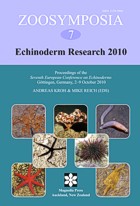Abstract
Over 2,000 Recent species of brittle star are currently known. The most active period of species discovery was between 1850 and 1950, with an average rate of about 20 new species per year, but even today, an average of 7 species per year are described. The most prolific authors were R. Koehler, H.L. Clark, T. Lyman, T. Mortensen and C. Lütken. Early classifications divided the Ophiuroidea into Euryalida and Ophiurida. Matsumoto suggested in 1917 further subdivision, accepted by some authors, rejected by others. His classification is still the most comprehensive work available. A first modern cladistic analysis was presented in 1995 by Smith et al., but despite its shortcomings, no further attempts at reconstructing the phylogeny of the whole class have been made. It is becoming increasingly clear that Ophiuroidea have undergone rapid evolution after the great extinction event at the Permian/Triassic boundary, complicating phylogenetic analysis both with morphological and molecular data. Palaeozoologists still debate which ophiuroid group(s) survived the extinction. It has been suggested that the modern families Ophiuridae and Ophiolepididae may be traced back to the Palaeozoic, but the traditional view puts Ophiacanthidae and Ophiomyxidae at the root of the tree, with Euryalida as ancient sister group to Ophiurida. Unusual species with aberrant traits abound, but are still poorly understood. New morphological approaches, such as the study of the internal skeleton (jaws, dental plates, lateral arm plates), ontogeny and the role of paedomorphosis, as well as the extensive use of SEM for microstructure examinations, attempt to improve our understanding of the diversity and evolution of brittle stars.

